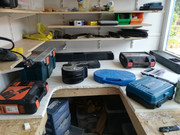https://www.youtube.com/channel/UCWSmzD ... MtkEl2l0zw
I have decided to go with the Dutch Digikeijs system, using a DR5000 as the control, with two DR4018 to control my MTB MP-1 motors for the points, and a DR4088CS for feedback. At present I have laid out the first two mainline tracks in the position I want them and have wired up the first section. Having purchased a loco, I have successfully installed the DCC decoder, and even managed to re write the CV's - all a massive learning curve. Now that I know the system does actually work, I can carry on soldering and installing the rest of the track. A big thank you to all that post here as your expertise and suggestions in the forum have really helped me work this all out.




